NATURAL
HABITATS
TERRESTIAL ENVIRONMENT
The Maltese landscape consists
of three key components which include built-up areas, agricultural land
and the natural countryside. A significant proportion (about 16% in Malta
and 10% in Gozo) of the land area of the islands is taken up by buildings
and roads. The increasing population of the Islands has increased the demands
for increased housing with significant inroads in the proportion of agricultural
land and natural countryside.  Registered
agricultural land fell from about 55% in 1957 to about 45% in 1968 and
to 38% in 1996. Even the natural countryside has been significantly influenced
by man's activities since the Islands' colonisation by Neolithic man. On
the macroscopic level, the Maltese Islands are generally regarded as having
an impoverished landscape, in part resulting from the limited topographical
variety and the poor soil cover, and in part from the arid environment
which supports a patchily distributed specialised vegetation. On a micro-level,
however, the Maltese Islands harbour a surprising range of habitat types
and biota which add variety to the landscape. Apart from the spatial heterogenicity,
there is also a temporal one as the vegetation changes with the seasons.
The biseasonality of the climate imposes a biseasonality in the landscapes,
particularly the steppes and garigues growing on the limestone karstlands.
As the land drys up during the summer months, the vegetation becomes very
sparse and the landscape becomes an expanse of bare rock with patches of
soil and occasional thorny bushes. During the wet period, every patch of
soil becomes covered with a carpet of green as the dormant vegetation resumes
growth.
Registered
agricultural land fell from about 55% in 1957 to about 45% in 1968 and
to 38% in 1996. Even the natural countryside has been significantly influenced
by man's activities since the Islands' colonisation by Neolithic man. On
the macroscopic level, the Maltese Islands are generally regarded as having
an impoverished landscape, in part resulting from the limited topographical
variety and the poor soil cover, and in part from the arid environment
which supports a patchily distributed specialised vegetation. On a micro-level,
however, the Maltese Islands harbour a surprising range of habitat types
and biota which add variety to the landscape. Apart from the spatial heterogenicity,
there is also a temporal one as the vegetation changes with the seasons.
The biseasonality of the climate imposes a biseasonality in the landscapes,
particularly the steppes and garigues growing on the limestone karstlands.
As the land drys up during the summer months, the vegetation becomes very
sparse and the landscape becomes an expanse of bare rock with patches of
soil and occasional thorny bushes. During the wet period, every patch of
soil becomes covered with a carpet of green as the dormant vegetation resumes
growth.
To survive the dry summer
months, most plants go into a state of reduced activity or dormancy in
the form of underground perennating structures (tubers, bulbs) or in the
form of seeds. All aerial parts of the plant dies and dries up. Other plants
are evergreen but have numerous adaptations to reduce water loss by transpiration
and to avoid overheating during the arid period. On such mechanism is sclerophylly
where the leaves have a thickened cuticle and are reduced in size to limit
transpiration. Some small plants manage to avoid the summer altogether.
Being annuals, these plant species concentrate their entire lives into
half a year. When the autumn rains come,they sprout leaves and grow quickly.
By spring they are in flower, but with the advent of summer they die after
scattering seeds wrapped in water-tight skins. Similar protective mechanisms
against the summer heat and drought are also taken by animals.
The Maltese landscape thus
presents are variety of habitat assemblages.
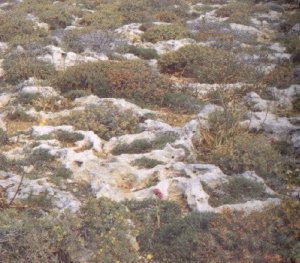 (1)
Garigue:
This habitat form is the most characteristic natural vegetation type present
on the Maltese Islands, particularly on the flat karstic limestone platforms
of western Malta and the Gozitan hilltops. Garigues are characterised by
low shrubs such as the Mediterranean Thyme, the Yellow Kidney Vetch, the
Olive-leaved Germander, the Mediterranean Heath and the Maltese Spurge.
These are accompanied by numerous geophytes and therophytes. While some
garigue areas are natural, others result from the degradation of forest
and maquis, when removal of the vegetation cover leads to extensive soil
erosion exposing large tracts of bed rock and leaving only patches of stony
soil.
(1)
Garigue:
This habitat form is the most characteristic natural vegetation type present
on the Maltese Islands, particularly on the flat karstic limestone platforms
of western Malta and the Gozitan hilltops. Garigues are characterised by
low shrubs such as the Mediterranean Thyme, the Yellow Kidney Vetch, the
Olive-leaved Germander, the Mediterranean Heath and the Maltese Spurge.
These are accompanied by numerous geophytes and therophytes. While some
garigue areas are natural, others result from the degradation of forest
and maquis, when removal of the vegetation cover leads to extensive soil
erosion exposing large tracts of bed rock and leaving only patches of stony
soil.
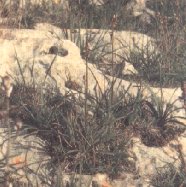 (2)
Steppes:
Steppes are widespread and result from the degradation of the maquis and
garigue mainly by grazing by goats and sheep. Some steppes develop on abandoned
agricultural land. These are dominated by grasses, umbellifers, thistles
and geophytes. Steppes also develop in situation where the soil cover and
the general conditions do not allow for the growth of larger plants or
shrubs. Thus steppes also characterise the talus clay slopes.
(2)
Steppes:
Steppes are widespread and result from the degradation of the maquis and
garigue mainly by grazing by goats and sheep. Some steppes develop on abandoned
agricultural land. These are dominated by grasses, umbellifers, thistles
and geophytes. Steppes also develop in situation where the soil cover and
the general conditions do not allow for the growth of larger plants or
shrubs. Thus steppes also characterise the talus clay slopes.
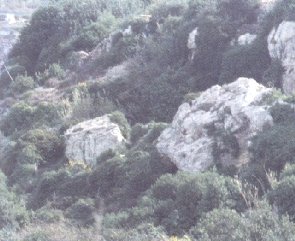 (3)
Maquis:
The Maltese maquis is an impoverished scrub community resulting from degeneration
of woodland due to cutting, grazing and the resultant soil erosion. The
local maquis is characterised by a number of small trees (Carob and olive)
and large shrubs (Olive-leaved Buckthorn, Mediterranean Honeysuckle, etc).
A semi-natural maquis survives in relatively inaccessible sites such as
the sides of steep valleys (widien) and the foot of inland cliffs
(rdum).
An artificial maquis develops round tress, mainly olives and carobs, planted
by man. Rdum are near vertical faces of rock formed either by erosion
or by tectonic movements. Their bases are invariably surrounded by screes
of boulders eroded from the edges. Because of the shelter they provide
and their relative inaccessibility, the sides and boulder screes provide
important refuges for many species of Maltese flora and fauna, promoting
rupestral habitat assemblages. Widien are drainage channels formed
either by stream erosion during the Pleistocene and/or by tectonic processes.
Most are now dry valleys and only carry water along their watercourses
during the winter months. A few drain perennial springs promoting the development
of freshwater habitat assemblages.
(3)
Maquis:
The Maltese maquis is an impoverished scrub community resulting from degeneration
of woodland due to cutting, grazing and the resultant soil erosion. The
local maquis is characterised by a number of small trees (Carob and olive)
and large shrubs (Olive-leaved Buckthorn, Mediterranean Honeysuckle, etc).
A semi-natural maquis survives in relatively inaccessible sites such as
the sides of steep valleys (widien) and the foot of inland cliffs
(rdum).
An artificial maquis develops round tress, mainly olives and carobs, planted
by man. Rdum are near vertical faces of rock formed either by erosion
or by tectonic movements. Their bases are invariably surrounded by screes
of boulders eroded from the edges. Because of the shelter they provide
and their relative inaccessibility, the sides and boulder screes provide
important refuges for many species of Maltese flora and fauna, promoting
rupestral habitat assemblages. Widien are drainage channels formed
either by stream erosion during the Pleistocene and/or by tectonic processes.
Most are now dry valleys and only carry water along their watercourses
during the winter months. A few drain perennial springs promoting the development
of freshwater habitat assemblages.
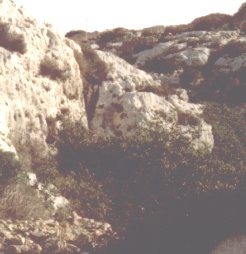 (4)
Rupestral
assemblages: The south, southwest and west coasts of Malta and
the south and southwest of Gozo consist of vertical cliffs, which in some
places give way to a steeply sloping substratum which is terranced and
partly under cltivation. A second tier of vertical cliffs (rdum)
can be found further inland. Because of the relative inaccessibility of
these sites, they provide an important refuge for many plant and animal
species, including a large number of endemic ones.
(4)
Rupestral
assemblages: The south, southwest and west coasts of Malta and
the south and southwest of Gozo consist of vertical cliffs, which in some
places give way to a steeply sloping substratum which is terranced and
partly under cltivation. A second tier of vertical cliffs (rdum)
can be found further inland. Because of the relative inaccessibility of
these sites, they provide an important refuge for many plant and animal
species, including a large number of endemic ones.
 (5)
Freshwater
assemblages: Freshwater assemblages in the Maltese Islands are
usually very transient since the rainwater pools dry up completely during
the summer months. Temporary rainwater pools house many freshwater plant
and animal species which are overall rare on the Islands. Some pools receive
water from sources other than rain or are of a sufficiently large size
as to remain more or less permanent. These pools are the only standing
water bodies of the Islands. Freshwater assemblages are generally found
along the valleys (widien).
(5)
Freshwater
assemblages: Freshwater assemblages in the Maltese Islands are
usually very transient since the rainwater pools dry up completely during
the summer months. Temporary rainwater pools house many freshwater plant
and animal species which are overall rare on the Islands. Some pools receive
water from sources other than rain or are of a sufficiently large size
as to remain more or less permanent. These pools are the only standing
water bodies of the Islands. Freshwater assemblages are generally found
along the valleys (widien).
 (6)
Woodland:
During the Pleistocene period, the Maltese Islands were apparently covered
with Mediterranean Sclerophyll Forest characterised by the Holm Oak and
Aleppo Pine. In the Maltese Islands, the natural forest is all but extinct,
except for four forest ramnants of small copses of Holm Oak. An artificial
woodland was created at Buskett in Malta. This has now become a self-regenerating
semi-natural woodland. The latter represents the only woodland ecosystem
in the Islands and harbours a large number of woodland trees and animals.
(6)
Woodland:
During the Pleistocene period, the Maltese Islands were apparently covered
with Mediterranean Sclerophyll Forest characterised by the Holm Oak and
Aleppo Pine. In the Maltese Islands, the natural forest is all but extinct,
except for four forest ramnants of small copses of Holm Oak. An artificial
woodland was created at Buskett in Malta. This has now become a self-regenerating
semi-natural woodland. The latter represents the only woodland ecosystem
in the Islands and harbours a large number of woodland trees and animals.
(7) Coastal
communities: Marshlands form an interface between marine, freshwater
and terrestial environments, and thus are characterised by a muddy substratum
with a cover of brackish water which dries out in the summer. Because of
the harsh conditions, saline marshlands support a highly specialised flora
and fauna. 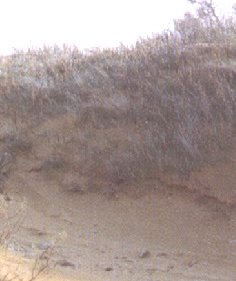 Another
important coastal community are the sand dunes found on several Maltese
sandy beaches. Beach development has however degraded many of these sand
dunes, and these have become amongst the rarest and most threatened of
local ecosystems. Those which are still vegetated harbour typical Mediterranean
dune communities such as the Sand Couch. The Southern Marram Grass has
been totally extirpated from these sites.
Another
important coastal community are the sand dunes found on several Maltese
sandy beaches. Beach development has however degraded many of these sand
dunes, and these have become amongst the rarest and most threatened of
local ecosystems. Those which are still vegetated harbour typical Mediterranean
dune communities such as the Sand Couch. The Southern Marram Grass has
been totally extirpated from these sites.
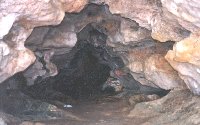
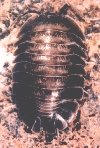 (8)
Cave
assemblages: The Maltese Islands have a number of deep caves
which house a variety of organisms specially adapted to live in such habitats.
A number of the invertebrate species are endemic and locally restricted
such as the cave-dwelling woodlouse Armadillidium aelleni found
at Ghar Hasan. One cave at Ghar Harq Hamiem (Malta) is unique in that it
houses a deep pool of freshwater.
(8)
Cave
assemblages: The Maltese Islands have a number of deep caves
which house a variety of organisms specially adapted to live in such habitats.
A number of the invertebrate species are endemic and locally restricted
such as the cave-dwelling woodlouse Armadillidium aelleni found
at Ghar Hasan. One cave at Ghar Harq Hamiem (Malta) is unique in that it
houses a deep pool of freshwater.
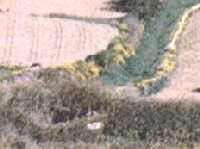 (9)
Disturbed
ground communities: The extensive land use has resulted in large
tracts of lands which have had marked disturbance of their ecologies. These
have resulted in various subtypes of distubed ground assemblages which
may include alien plant species in localities such as used and abandoned
fields, along roadsides and disturbed seaside habitats.
(9)
Disturbed
ground communities: The extensive land use has resulted in large
tracts of lands which have had marked disturbance of their ecologies. These
have resulted in various subtypes of distubed ground assemblages which
may include alien plant species in localities such as used and abandoned
fields, along roadsides and disturbed seaside habitats.

 (1)
Garigue:
This habitat form is the most characteristic natural vegetation type present
on the Maltese Islands, particularly on the flat karstic limestone platforms
of western Malta and the Gozitan hilltops. Garigues are characterised by
low shrubs such as the Mediterranean Thyme, the Yellow Kidney Vetch, the
Olive-leaved Germander, the Mediterranean Heath and the Maltese Spurge.
These are accompanied by numerous geophytes and therophytes. While some
garigue areas are natural, others result from the degradation of forest
and maquis, when removal of the vegetation cover leads to extensive soil
erosion exposing large tracts of bed rock and leaving only patches of stony
soil.
(1)
Garigue:
This habitat form is the most characteristic natural vegetation type present
on the Maltese Islands, particularly on the flat karstic limestone platforms
of western Malta and the Gozitan hilltops. Garigues are characterised by
low shrubs such as the Mediterranean Thyme, the Yellow Kidney Vetch, the
Olive-leaved Germander, the Mediterranean Heath and the Maltese Spurge.
These are accompanied by numerous geophytes and therophytes. While some
garigue areas are natural, others result from the degradation of forest
and maquis, when removal of the vegetation cover leads to extensive soil
erosion exposing large tracts of bed rock and leaving only patches of stony
soil.
 Registered
agricultural land fell from about 55% in 1957 to about 45% in 1968 and
to 38% in 1996. Even the natural countryside has been significantly influenced
by man's activities since the Islands' colonisation by Neolithic man. On
the macroscopic level, the Maltese Islands are generally regarded as having
an impoverished landscape, in part resulting from the limited topographical
variety and the poor soil cover, and in part from the arid environment
which supports a patchily distributed specialised vegetation. On a micro-level,
however, the Maltese Islands harbour a surprising range of habitat types
and biota which add variety to the landscape. Apart from the spatial heterogenicity,
there is also a temporal one as the vegetation changes with the seasons.
The biseasonality of the climate imposes a biseasonality in the landscapes,
particularly the steppes and garigues growing on the limestone karstlands.
As the land drys up during the summer months, the vegetation becomes very
sparse and the landscape becomes an expanse of bare rock with patches of
soil and occasional thorny bushes. During the wet period, every patch of
soil becomes covered with a carpet of green as the dormant vegetation resumes
growth.
Registered
agricultural land fell from about 55% in 1957 to about 45% in 1968 and
to 38% in 1996. Even the natural countryside has been significantly influenced
by man's activities since the Islands' colonisation by Neolithic man. On
the macroscopic level, the Maltese Islands are generally regarded as having
an impoverished landscape, in part resulting from the limited topographical
variety and the poor soil cover, and in part from the arid environment
which supports a patchily distributed specialised vegetation. On a micro-level,
however, the Maltese Islands harbour a surprising range of habitat types
and biota which add variety to the landscape. Apart from the spatial heterogenicity,
there is also a temporal one as the vegetation changes with the seasons.
The biseasonality of the climate imposes a biseasonality in the landscapes,
particularly the steppes and garigues growing on the limestone karstlands.
As the land drys up during the summer months, the vegetation becomes very
sparse and the landscape becomes an expanse of bare rock with patches of
soil and occasional thorny bushes. During the wet period, every patch of
soil becomes covered with a carpet of green as the dormant vegetation resumes
growth.
 (2)
Steppes:
Steppes are widespread and result from the degradation of the maquis and
garigue mainly by grazing by goats and sheep. Some steppes develop on abandoned
agricultural land. These are dominated by grasses, umbellifers, thistles
and geophytes. Steppes also develop in situation where the soil cover and
the general conditions do not allow for the growth of larger plants or
shrubs. Thus steppes also characterise the talus clay slopes.
(2)
Steppes:
Steppes are widespread and result from the degradation of the maquis and
garigue mainly by grazing by goats and sheep. Some steppes develop on abandoned
agricultural land. These are dominated by grasses, umbellifers, thistles
and geophytes. Steppes also develop in situation where the soil cover and
the general conditions do not allow for the growth of larger plants or
shrubs. Thus steppes also characterise the talus clay slopes.
 (3)
Maquis:
The Maltese maquis is an impoverished scrub community resulting from degeneration
of woodland due to cutting, grazing and the resultant soil erosion. The
local maquis is characterised by a number of small trees (Carob and olive)
and large shrubs (Olive-leaved Buckthorn, Mediterranean Honeysuckle, etc).
A semi-natural maquis survives in relatively inaccessible sites such as
the sides of steep valleys (widien) and the foot of inland cliffs
(rdum).
An artificial maquis develops round tress, mainly olives and carobs, planted
by man. Rdum are near vertical faces of rock formed either by erosion
or by tectonic movements. Their bases are invariably surrounded by screes
of boulders eroded from the edges. Because of the shelter they provide
and their relative inaccessibility, the sides and boulder screes provide
important refuges for many species of Maltese flora and fauna, promoting
rupestral habitat assemblages. Widien are drainage channels formed
either by stream erosion during the Pleistocene and/or by tectonic processes.
Most are now dry valleys and only carry water along their watercourses
during the winter months. A few drain perennial springs promoting the development
of freshwater habitat assemblages.
(3)
Maquis:
The Maltese maquis is an impoverished scrub community resulting from degeneration
of woodland due to cutting, grazing and the resultant soil erosion. The
local maquis is characterised by a number of small trees (Carob and olive)
and large shrubs (Olive-leaved Buckthorn, Mediterranean Honeysuckle, etc).
A semi-natural maquis survives in relatively inaccessible sites such as
the sides of steep valleys (widien) and the foot of inland cliffs
(rdum).
An artificial maquis develops round tress, mainly olives and carobs, planted
by man. Rdum are near vertical faces of rock formed either by erosion
or by tectonic movements. Their bases are invariably surrounded by screes
of boulders eroded from the edges. Because of the shelter they provide
and their relative inaccessibility, the sides and boulder screes provide
important refuges for many species of Maltese flora and fauna, promoting
rupestral habitat assemblages. Widien are drainage channels formed
either by stream erosion during the Pleistocene and/or by tectonic processes.
Most are now dry valleys and only carry water along their watercourses
during the winter months. A few drain perennial springs promoting the development
of freshwater habitat assemblages.
 (4)
Rupestral
assemblages: The south, southwest and west coasts of Malta and
the south and southwest of Gozo consist of vertical cliffs, which in some
places give way to a steeply sloping substratum which is terranced and
partly under cltivation. A second tier of vertical cliffs (rdum)
can be found further inland. Because of the relative inaccessibility of
these sites, they provide an important refuge for many plant and animal
species, including a large number of endemic ones.
(4)
Rupestral
assemblages: The south, southwest and west coasts of Malta and
the south and southwest of Gozo consist of vertical cliffs, which in some
places give way to a steeply sloping substratum which is terranced and
partly under cltivation. A second tier of vertical cliffs (rdum)
can be found further inland. Because of the relative inaccessibility of
these sites, they provide an important refuge for many plant and animal
species, including a large number of endemic ones.
 (5)
Freshwater
assemblages: Freshwater assemblages in the Maltese Islands are
usually very transient since the rainwater pools dry up completely during
the summer months. Temporary rainwater pools house many freshwater plant
and animal species which are overall rare on the Islands. Some pools receive
water from sources other than rain or are of a sufficiently large size
as to remain more or less permanent. These pools are the only standing
water bodies of the Islands. Freshwater assemblages are generally found
along the valleys (widien).
(5)
Freshwater
assemblages: Freshwater assemblages in the Maltese Islands are
usually very transient since the rainwater pools dry up completely during
the summer months. Temporary rainwater pools house many freshwater plant
and animal species which are overall rare on the Islands. Some pools receive
water from sources other than rain or are of a sufficiently large size
as to remain more or less permanent. These pools are the only standing
water bodies of the Islands. Freshwater assemblages are generally found
along the valleys (widien).
 (6)
Woodland:
During the Pleistocene period, the Maltese Islands were apparently covered
with Mediterranean Sclerophyll Forest characterised by the Holm Oak and
Aleppo Pine. In the Maltese Islands, the natural forest is all but extinct,
except for four forest ramnants of small copses of Holm Oak. An artificial
woodland was created at Buskett in Malta. This has now become a self-regenerating
semi-natural woodland. The latter represents the only woodland ecosystem
in the Islands and harbours a large number of woodland trees and animals.
(6)
Woodland:
During the Pleistocene period, the Maltese Islands were apparently covered
with Mediterranean Sclerophyll Forest characterised by the Holm Oak and
Aleppo Pine. In the Maltese Islands, the natural forest is all but extinct,
except for four forest ramnants of small copses of Holm Oak. An artificial
woodland was created at Buskett in Malta. This has now become a self-regenerating
semi-natural woodland. The latter represents the only woodland ecosystem
in the Islands and harbours a large number of woodland trees and animals.
 Another
important coastal community are the sand dunes found on several Maltese
sandy beaches. Beach development has however degraded many of these sand
dunes, and these have become amongst the rarest and most threatened of
local ecosystems. Those which are still vegetated harbour typical Mediterranean
dune communities such as the Sand Couch. The Southern Marram Grass has
been totally extirpated from these sites.
Another
important coastal community are the sand dunes found on several Maltese
sandy beaches. Beach development has however degraded many of these sand
dunes, and these have become amongst the rarest and most threatened of
local ecosystems. Those which are still vegetated harbour typical Mediterranean
dune communities such as the Sand Couch. The Southern Marram Grass has
been totally extirpated from these sites.

 (8)
Cave
assemblages: The Maltese Islands have a number of deep caves
which house a variety of organisms specially adapted to live in such habitats.
A number of the invertebrate species are endemic and locally restricted
such as the cave-dwelling woodlouse Armadillidium aelleni found
at Ghar Hasan. One cave at Ghar Harq Hamiem (Malta) is unique in that it
houses a deep pool of freshwater.
(8)
Cave
assemblages: The Maltese Islands have a number of deep caves
which house a variety of organisms specially adapted to live in such habitats.
A number of the invertebrate species are endemic and locally restricted
such as the cave-dwelling woodlouse Armadillidium aelleni found
at Ghar Hasan. One cave at Ghar Harq Hamiem (Malta) is unique in that it
houses a deep pool of freshwater.
 (9)
Disturbed
ground communities: The extensive land use has resulted in large
tracts of lands which have had marked disturbance of their ecologies. These
have resulted in various subtypes of distubed ground assemblages which
may include alien plant species in localities such as used and abandoned
fields, along roadsides and disturbed seaside habitats.
(9)
Disturbed
ground communities: The extensive land use has resulted in large
tracts of lands which have had marked disturbance of their ecologies. These
have resulted in various subtypes of distubed ground assemblages which
may include alien plant species in localities such as used and abandoned
fields, along roadsides and disturbed seaside habitats.